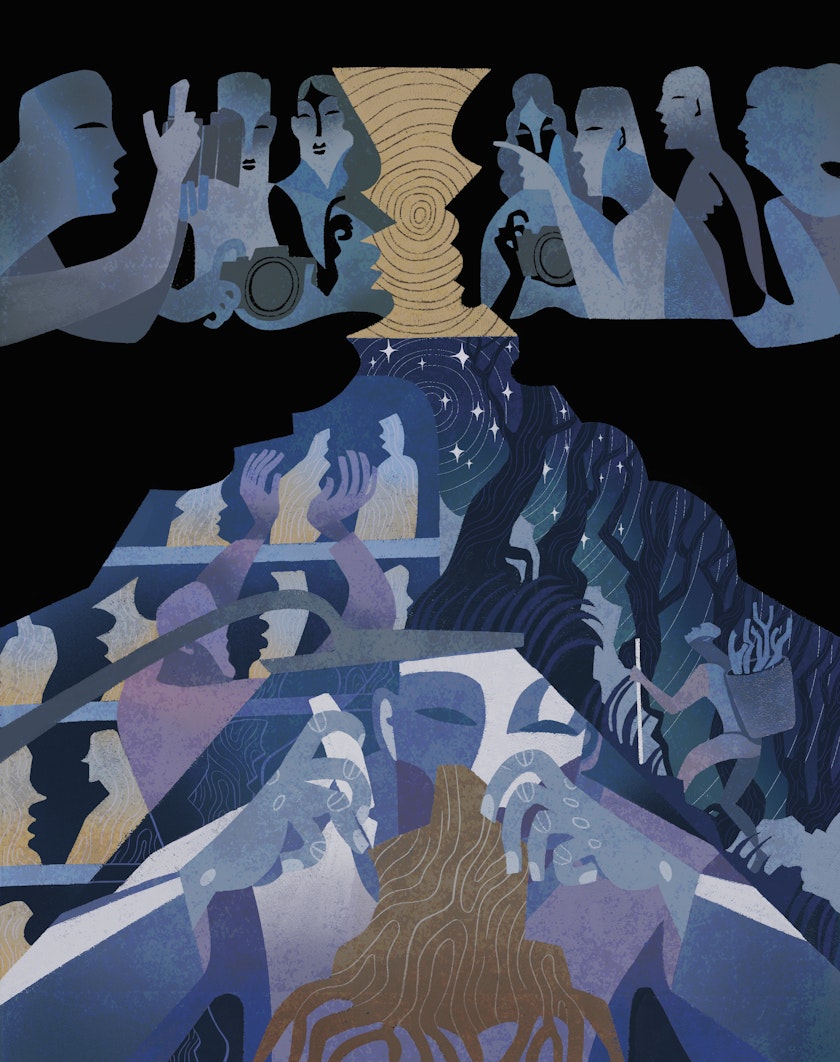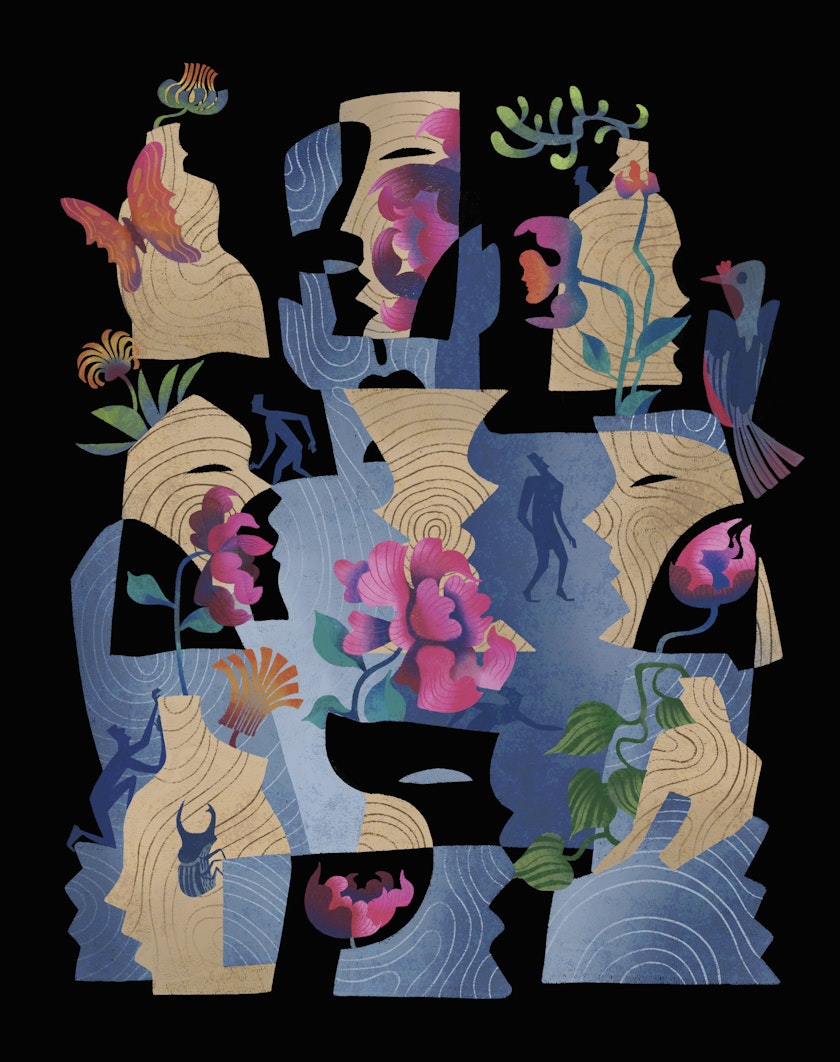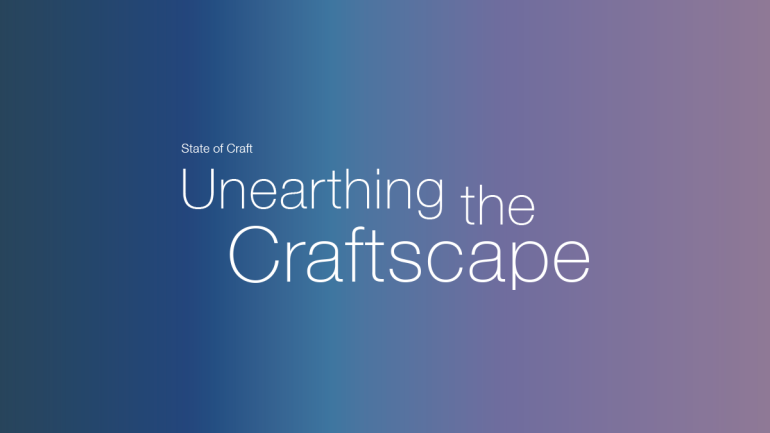Unearthing the Craftscape
Unearthing the Craftscape
“I worked for two years as their research assistant, and it opened up this space . . . to figure out how to be interdisciplinary between anthropology and art history,” she remembers.
Wiggers, who was born in the US to Indian immigrant parents, shifted the focus of her research, deciding to look at how South Asian immigrants use everyday objects to transform cookie-cutter American houses into a place like home—an “anthropological, aesthetics-of-everyday, craft-oriented dissertation,” as she puts it.
She kept up her coursework for art history and started taking classes in other departments, including anthropology and South Asian studies. But, as she interviewed Indian immigrants about the various objects they brought over to re-create a place like home, including textiles and small statues of Hindu gods and goddesses called murti, Wiggers realized that what she really wanted to study was craft. Her department, which at the time took a traditional approach to teaching art history, was less than enthused.
“They were like, ‘What? No, you’re not going to study craft. Absolutely not,’” she recalls. “Craft was not considered an appropriate topic.”

Illustration copyright Daren Lin 2021.
Fast-forward to 2021, and things have shifted. People are still debating the art-versus-craft question, but in the past 10 to 15 years craft curation has received an unprecedented amount of academic interest, and more craft-focused institutions have opened or renewed their missions in the United States than at any time since the early 20th century, when the American studio craft movement flourished. Museums are also expanding their craft collections. In November, for example, the Windgate Foundation gave $17.5 million to the Crystal Bridges Museum of American Art to create a dedicated curatorial position for craft and help increase craft acquisitions.
The Craftscape
And yet, for Wiggers, the question is not about whether craft is art; the goal of making craft reach “the status of art,” she says, feels irrelevant. Instead, she wants to move outside the craft-versus-art binary to focus on what she calls a craftscape, a term she coined in 2010 to describe a way of reframing craft not just as commodity objects that are sold, collected, or exhibited, but as social objects that are inscribed with histories and narratives that can tell us something about the world.
In other words, who makes something and how they make it is as vital as what is made. Seen this way, the craftscape is essentially a decolonized lens through which to see the world, one that continually questions how knowledge is produced and pushes back against dominant narratives and histories around craft objects.
Wiggers credits her mentor Arjun Appadurai with sparking the idea behind the craftscape. Appadurai’s five “scapes” of globalization—ethnoscapes, technoscapes, ideoscapes, financescapes, and mediascapes—describe how different spheres of culture overlap and influence each other in a globalized world. “One of the things that Appadurai’s book The Social Life of Things opened is space to understand how objects circulate and create meaning outside of and in addition to economic structures,” Wiggers explains. “I am working on ways to expand our understanding of craft as more of a system. The power and strength of craft does not come only from the art world, but also from its breadth and depth across cultural connections.”
Wiggers’ idea of a craftscape powers her work as director of the MA program in Critical Craft Studies at Warren Wilson College—the first program in the country to focus its curriculum solely on craft history and theory. In contrast, traditional maker programs, like those at Haystack and Penland, for example, provide students the opportunity to spend weeks or months working with materials such as ceramics, fiber, glass, and wood. There are other academic programs, like Bard Graduate Center, that take a material culture approach, with media-specific craft histories often taught by art professors to support their making-oriented curriculum. But the Critical Craft Studies program views craft as a field of study in and of itself and pulls from art history, anthropology, social history, material culture, literary theory—and more—to create its interdisciplinary curriculum and assemble its teaching staff.
“We are not a making program” in the traditional sense, says Wiggers, cofounder of the Critical Craft Forum, who worked for years after leaving graduate school as a studio jeweler and later a curator at the Museum of Contemporary Craft in Portland, Oregon. “What we make is history and theory—we make books, we make texts, we make oral histories, we make documents that go into archives, and more, as a way of understanding the objects and the people who are making them and where they sit culturally.”
While the students are exposed to the raw materials used in the fiber arts, blacksmithing, and woodworking, it’s more in the service of reconnecting craft with the landscape and acknowledging the labor involved in transforming these materials into something that is usable. “What we’re trying to do through the critical craft program . . . is to teach where those raw materials actually come from and be involved from the ground up,” says Dave Ellum, a professor of ecological forestry and the dean of land resources at Warren Wilson College, who walks Critical Craft Studies students through the North Carolina college’s 1,135-acre campus to learn how to read a forest.
“The power and strength of craft does not come only from the art world, but also from its breadth and depth across cultural connections.”
“Contemporary visual-arts discourse . . . prioritizes the finished object with emphasis on the labor and transformative processes engaged by an artist or craftsperson in the production of that object,” says Wiggers, “and this exacerbates the distance between craft materials and the earth itself.” It’s very different, she adds, to understand that a fiber craft, for example, begins with a seed versus the purchase of a textile from a store.
Beyond Beauty
Tiffany Momon, PhD, who teaches in the Critical Craft Studies program and will join its core faculty in the fall, is doing exactly the kind of “making” Wiggers describes with the Black Craftspeople Digital Archive. The website Momon founded in 2019 documents the contributions that Black craftspeople—both free and enslaved—have made to the decorative-arts tradition of the United States. “There’s definitely a decolonizing angle to this work,” Momon says, “because what we’re saying is, if you’re a cabinet-maker from South Carolina but you also enslaved Black cabinet-makers, you no longer get to claim sole ownership over the objects that were created.”
Momon recently taught a workshop at Warren Wilson College called “The Lives and Legacies of Black Craftspeople,” which covered the wide range of objects, including textiles, furniture, and silver pieces, that Black craftspeople made during the 18th and 19th centuries. Instead of centering the objects, Momon concentrated on the creators themselves in order to unearth the craftscape—or, as she puts it, “the hidden landscape”—embedded in these objects. “People in the decorative arts get very hung up on what objects look like,” says Momon. “You know, they are very connoisseur-like—they might look at a table and say, ‘What’s the primary wood? What’s the secondary wood?’ I’m pretty sure this will piss off art historians from here to wherever, but for me, it’s really a people thing, because one, you don’t get an object without a person—without their artistry, creativity, and skill—and two, I’m looking for something that goes beyond just surface-level appreciation of the beauty of an object.”
That speaks to Wiggers, who recalls an incident a few years ago at the Textile Society of America’s 15th Biennial Symposium, which focused on the ways textiles are shaped by colonization and globalization. She organized an exhibit called Cotton, Beads & Sugar: Textile Triangulations of Coastal Exchange between India, Africa & US. It featured many objects, including a beaded bag made by designer Medha Bhatt Ganguly’s great-great-grandmother. During a seminar connected to the exhibition, says Wiggers, a prominent artist and educator stood up and “lamented that he just wanted to talk about the beauty of the beaded bag, complaining that ‘we’ should be able to just talk about how beautiful objects like this are.” In response, Bhatt Ganguly said that the bag was something her great-great-grandmother took with her when she got married, at a very young age, to showcase the stitches and beadwork she had learned from her mother, aunts, and sisters, most of whom she was unlikely to see again. She also shared that as her great-great-grandmother was about to leave for her husband’s home, her father told her, “If they beat you, if they hurt you in any way, better that you throw yourself in a well, because you cannot come home,” Wiggers recalls.
“This object represents that patriarchal structure that sent her away—she only saw her mother one more time after that,” says Wiggers. “It’s a story that the object doesn’t visibly convey, but it is very much a part of craft histories and the kinds of histories that we hope our program can continue to bring into view.”
Exploding the Binaries
Michael Hatch, a glassblower who is one of nine inaugural graduates of the Warren Wilson College program, says his time there helped him see that “everything is part of something bigger and that nothing exists in a vacuum.” Last fall, Hatch exhibited his project Crafted Roots: Stories and Objects from the Appalachian Mountains, which delved into oral histories of regional craftspeople and the urban missionaries and educators who came down from the North in the early 20th century. The urban missionaries ostensibly wanted to help improve the lives of those in the region, but Hatch, who spent three years listening to previously untapped oral histories from the archives of the Southern Highland Craft Guild, says that when you listen to the missionaries and regional craftspeople speaking for themselves, you can hear nuances to that story.

Illustration copyright Daren Lin 2021.
“What the interviews really revealed was that there are individuals within both of these groups,” Hatch says. “For example, among the missionaries, people had different reasons for coming down here. They definitely wanted to improve the lives of people, but they also had personal reasons, which included the adventure of going to a place that was quite different from what they were accustomed to.”
Hatch points to Winogene Redding, a young, privileged woman from Boston who was inspired to come to Eastern Kentucky in 1925 after reading an article in The Atlantic Monthly about the region. “I had read these stories and had known someone who had been down here . . . and had a good time and thought it was a big adventure,” she says in an oral-history recording. “And I was young and ready for anything. My family nearly had a fit.”
There were hundreds of people who came to the region, Hatch says, each led by their own blend of motivations. “In academic circles,” he says, “we spend a lot of time talking about people and referencing others who have previously talked about them. Oral histories allow people to speak for themselves. They provide a path to de-essentialize our thinking about groups of people by focusing on individual identities within these groups.”
This exploding of binaries, whether it’s art versus craft or, in this case, urban missionaries versus rural craftspeople, is part of the craftscape’s decolonizing approach to dismantling dominant histories and narratives. “Because of the way we have been educated, we tend to think in binaries,” says Wiggers. “But we’ve seen that binaries don’t work—they don’t work for gender, they don’t work for race, they don’t work for a lot of things. And that is something we are embracing in this program: that nothing ever fits neatly into a single category.”
Pushing the Boundaries
Mellanee Goodman, a student who graduated this spring, says the program pushed the boundaries of what an education can look like. “The pedagogies and theories that I learned and experienced in this program are definitely an elevation of what a craft education can be,” she says. “It’s not just textbook learning from an old white dude who’s talking about, like, African pots, you know?”
A key part of that education, says core faculty member and writer, educator, curator, and artist Benjamin Lignel, is the craft of asking questions—both about what’s there and what’s not there: “This program is nurturing dispositions or attitudes which are critical, which are about trying to unpack the way that certain objects are related to these longer histories. What I hope is that students come out of this program with a willingness or a fire that is going to push them to continue to ask those questions.”
“I’m looking for something that goes beyond just surface-level appreciation of the beauty of an object.”
When it comes to decolonizing craft and building the craftscape, the institutions—including museums, funding organizations, and arts administrators—also need to do better. Instead of diversity and inclusion, says Tiffany Momon, the buzzword right now should be equity.
“When George Floyd was murdered, you had everybody and their grandmother’s museum and historic site coming out with messages of unity and ‘let’s all be better’ and yadda, yadda, yadda, but what have they actually done?” Momon says. “I think there are many instances where museums were doing just enough—and really, that was way too little—so that you couldn’t say they were racist. But it’s about more than running one exhibition on quilters and including some clothes made by Black women. It’s hard to tell diverse stories if you don’t have the staff that’s trained in it and if you don’t have the objects to tell these stories because of the biases of your past curators and collections managers.”
Wiggers agrees that museums are part of the problem. She, too, has called for more than simply adding exhibitions, collections, or programs. “Decolonization is a process—it’s not just a label or something where you can go ‘Tick, we’ve decolonized!’” Instead, she says, we need to rethink our approach to craft altogether.
“We’re not inviting people to a table that has already been set,” she says. “We’re inviting people in to do the messy work of figuring out what that table needs to look like—and this is different from the pipeline that has ostensibly been moving people who have been underrepresented in museum work through the system.”
Tiffany Momon says there is a lot of work to be done, but her students and the younger generation give her hope. “I often think about how protest movements are frequently led by the youth,” she says. “I always like to tell students that just because something has always been done one way, that doesn’t mean we have to continue to do it that way. I ask students to consider what the future of the field looks like.
“Because if we have an idea of what we want in the future, there’s no better time to start working on that than now.”
◆
Anjula Razdan is a Minneapolis-based writer and editor.
"the good china"
I am a child of the Midwest, the rusty place of industrialization and immigrants filtering through Detroit as labor. On holidays the table was set with the special dinnerware—pieces carried over by immigrants from Europe, passed down as heirloom, and gifted on special occasions. “The good china,” as it has been called. The bone china. Little was I aware then of the full movement of my meal beyond the passing of the plates in a clockwise motion collecting gravy, dressing, and bean casserole. Little was I aware that beyond that there was hunger.
Created in England in the mid-18th century, bone porcelain is made via a process of adding bone ash to soft-paste porcelain bodies. Buffalo Bone China (1997) by artist Dana Claxton and the writing of Paul Seesequasis narrate the possibility of bones from the buffalo slaughtered to near extinction on the Great Plains being transported through bone brokers to England to be used in bone china, resulting in what Kathryn Yusoff, author of A Billion Black Anthropocenes or None and professor of inhuman geography at Queen Mary University of London, might refer to as a “bad material formulation.” The dishware that brings my meal has possibly taken another’s.
Some might say there is no hard proof, but I also must ask you to remember that history was written by the victor. I write was written in past tense as I believe in a multiplicity known as historiography: that there are many lives and many narratives wrapped around an object. Stories of family, new beginnings, and growth, but also of death, genocide, and erasure. I believe that most objects with long lives reflect the cycles of entropy, both natural and violently enforced. The problem comes when we do not listen to all the stories. When the bad isn’t taken with the good and we try and turn our heads away.
As scholars Eve Tuck and K. Wayne Yang point out, decolonizing is not a metaphor. It is an act of giving land and space back. It is not a focus on the guilt of the meal eaten from the plate, but a question of what we now do with the profits of those past meals to propel acts of reparation.
◆
matt lambert is a nonbinary, trans, multidisciplinary collaborator and co-conspirator currently living in Stockholm, Sweden, as a PhD student between Konstfack and HDK Valand. They hold an MA in Critical Craft Studies from Warren Wilson College and an MFA in Metalsmithing from Cranbrook Academy of Art.
Don't miss out on stories like this one
Subcribe to American Craft magazine by June 21 to receiove the Summer 2021 issue where this article appears as well as three more beautiful issues in the year ahead.

This activity is made possible by the voters of Minnesota through a Minnesota State Arts Board Operating Support grant, thanks to a legislative appropriation from the arts and cultural heritage fund.




